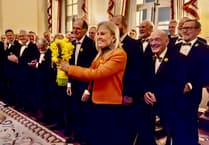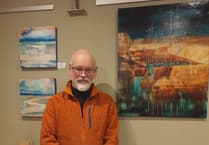Ross-on-Wye Arts Society Monthly Report
The first lecture of 2024 was all about a Dorset born man who migrated in 1869, as young child with his widowed mother, and became Australia’s most famous artist.
As a young man Tom Roberts returned to Europe several times to study painting and mix with the avant garde Impressionists. He used what he learned to develop a series of paintings telling the story of Europeans in Australia, their way of life and achievements. He was a member of what became known as the Heidelberg School of artists (a rural area outside Melbourne). His most famous work is The Shearing of the Rams, which appears on an Australian stamp and is used in schools to teach about the history of Australia.
The audience of Arts Society members and visitors was amazed to learn many of the pieces completed by Heidelberg School members were just 9”x5” (22.5x12.5cm) because they used panels from cigar boxes to paint on. Paul Chapman’s lecture was a fascinating look at a little known to British audiences school of painting on the other side of the world.
The next Ross Arts Society lecture will be on held on Monday April 8 at 2.15pm in The Larruperz Centre. The subject being covered is St Pancras and Friends: A Journey Through London’s Stations.
For more information about the programme and membership please visit our website- www.theartssociety-rossonwye.org
The Arts Society Ross-on-Wye is part of a national membership organisation. You can find us on Facebook @TheArtsSocietyRossonWye and Instagram @RossArts.
Wild about Ross
When it comes to gardening, working with nature has tremendous advantages. Not only can you create a wildlife garden with lots of wildlife features but you can also get a lot of help and support from nature's helpers. I grow all my own vegetables and fruits spending only an hour a day and it doesn't feel like work but rather as play and learning.
The most important word here is biodiversity. Obviously biodiversity is important for the sustainability of natural environments, but it's also great for the gardener. Nature is a complex, multi-layered, interconnected system that thrives when it is in balance, and it's in balance when there is large-scale biodiversity. So when we work on biodiversity no single species dominates, which means that any pests in the garden are kept in balance by predators.
This starts on the soil, which is an ecosystem in its own right. It’s full of microorganisms, and small creatures, not just worms. It is also comprehensively connected via a network of mycelium. This network connects the plants with the nutrients they need, whilst also providing an information superhighway much like the world wide web, enabling plants to share information and protect each other.
So how does this help the gardener? Well firstly the best thing we can do is not destroy this beneficial environment and we can do this by not digging the soil. Instead we should build soil health by applying organic matter to the surface, much as nature does in the woods when leaves drop. It also saves a lot of work and the small creatures in the soil are like volunteers conditioning the soil to allow for better drainage as well as moisture retention and processing waste materials into resources.
The best way to build your soil is with home made compost. The compost not only feeds your soil but also provides habitats for more micro-organisms as well as reptiles like toads and slow-worms. Top dress the soil every year and the soil life will integrate it into the soil providing a rich medium for plants to thrive, whilst also suppressing weeds. There are many different ways to make compost including vermiculture (using worms), bokashi (fermentation) or a simple plastic compost bin or a pile in the corner of the garden.
Biodiversity also works above the soil. Creating a garden with as many species as possible creates food for many different species of insects and pollinators. Without needing detailed knowledge of how different species provide benefits in the garden, and by employing bio-diversity we find that nature knows how to create balance.
Biodiversity involves giving the weeds a thought too, for instance ladybirds love nettles so getting rid of the weeds may impact your wildlife. Weed roots create channels for the soil to absorb water and increase air in the soil, weeds prevent evaporation, sequester carbon and some of them taste good too! When you do need to weed, leave the root in place.
Go along to Wild abut Ross’s “Wild about Gardens” workshop held on Saturday, March 23 at 9:30am if you would like to find out more. The workshop will be held at the Baptist Church in Broad Street. You can book for the workshop through Eventbrite via https://www.eventbrite.co.uk/e/wild-about-gardens-half-day-workshop-tickets-820089318227?aff=ebdssbdestsearch.
RBL take to the skies (well almost!)
One cold and misty Saturday morning in February, a group of Longhope and District Royal British Legion members met at the Jet Age Museum, Staverton , to visit the Gloucestershire Aviation Collection which is now over 30 years old.
The jet engine was designed by British engineering genius Sir Frank Whittle (1907-1996). His son Ian is a patron of the Jet Age Museum.
During the visit many of the members recalled fond memories of some of the aircraft when it was in its flying days, plus actually being able to sit in some of the cockpits to really get a feel for what it was like to fly some of these amazing aircraft, these included the Avro Vulcan Bomber and the Hawker Siddeley Trident.
The museum is open Saturday and Sundays 10am to 4pm more details on www.jetagemuseum.org. And all the members agreed that it was a most interesting and enlightening visit to see and lean about the Gloucestershire Aviation history.
Longhope branch meet monthly on the second Tuesday at The Latchen Room, Longhope , 7pm for 7:30pm start. There is a small pop up pub plus tea/coffee and biscuits plus a very warm welcome to all visitors. We look forward to seeing you.




